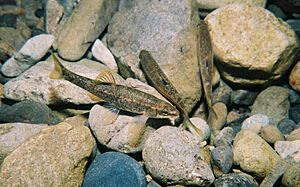Speckled dace facts for kids
Quick facts for kids Speckled dace |
|
|---|---|
 |
|
| Conservation status | |
| Scientific classification | |
| Synonyms | |
|
The speckled dace (Rhinichthys osculus) is a small freshwater fish. It is also known as the spotted dace or carpita pinta. This fish belongs to the minnow family, which includes many types of small freshwater fish. You can find speckled dace in cool freshwater areas across North America. Their home ranges from Sonora, Mexico, all the way up to British Columbia, Canada.
Contents
Where Speckled Dace Live
Speckled dace live in many parts of North America. Canada is the most northern place where they are found. In Canada, they live only in certain parts of the Kettle and Granby Rivers.
Traveling After the Ice Age
Scientists think that the speckled dace might have been one of the first fish to return to the rivers of British Columbia. This happened after the last Ice Age ended. They likely moved into these rivers along with another fish called the Salish sucker.
What Speckled Dace Look Like
The speckled dace is a small fish. It usually grows to be about 4 to 5 inches (10 to 13 centimeters) long.
What Speckled Dace Eat
Speckled dace are omnivorous, which means they eat both plants and animals. Their diet includes stringy algae and other plant materials. They also like to eat insects that live at the bottom of the water. Tiny water animals called zooplankton are also part of their meals.
Reproduction and Life Cycle
Speckled dace in Canada usually spawn (lay eggs) once a year. This happens during the summer months. Only fish older than two years are ready to breed.
How They Lay Eggs
During breeding season, many male dace will swim with one female. The female releases her sticky eggs over the gravelly bottom of the stream bed. Each female can lay between 200 and 500 eggs.
Speckled Dace Subspecies
There are several different types, or subspecies, of speckled dace. Each subspecies might live in a specific area. Some of these include:
- R. o. larversi - Big Smoky Valley speckled dace
- R. o. lethoporus - Independence Valley speckled dace
- R. o. moapae - Moapa speckled dace
- R. o. nevadensis - Ash Meadows speckled dace
- R. o. oligoporus - Clover Valley speckled dace
- R. o. thermalis - Kendall Warm Springs dace
- R. o. velifer - Pahranagat speckled dace
- R. o. ssp - Foskett speckled dace
- R. o. ssp - Santa Ana speckled dace
- R. o. ssp - Owens speckled dace
- R. o. ssp - Amargosa Canyon speckled dace
- R. o. ssp - Oasis Valley speckled dace
- R. o. ssp - Long Valley speckled dace
- R. o. ssp - Meadow Valley Wash speckled dace
- R. o. ssp - White River speckled dace
- R. o. ssp - Monitor Valley speckled dace
Protecting the Speckled Dace
Some populations of speckled dace need special protection.
The Foskett Speckled Dace
The Foskett speckled dace lives in tough desert waters in parts of Southeastern Oregon and Nevada. Because of these difficult living conditions, this subspecies has been listed as threatened since 1985. This means it has special protections under the Endangered Species Act.
From 2011 to 2016, the number of Foskett speckled dace changed a lot. It went from a low of 1,728 fish to a high of 24,888 fish. Before it was listed as threatened, there were only about 1,500 to 2,000 of them.
In 2018, officials from the U.S. Fish and Wildlife Service suggested that this fish might no longer need federal protection. This is because their numbers have grown so much. Robyn Thorson, a director at the Service, said that this success is thanks to partners who worked hard to help the dace recover. This good news follows other successes, like two other Oregon fish, the Oregon chub and the Modoc sucker, which were also removed from the threatened list because their populations recovered.


